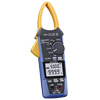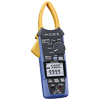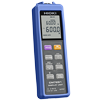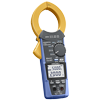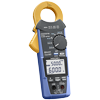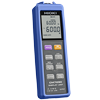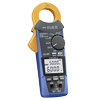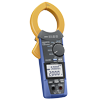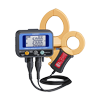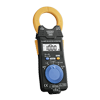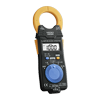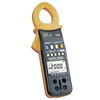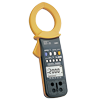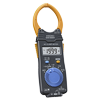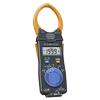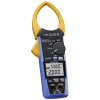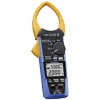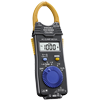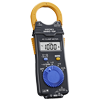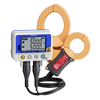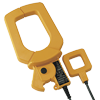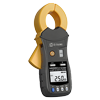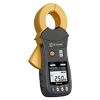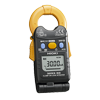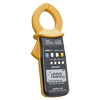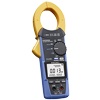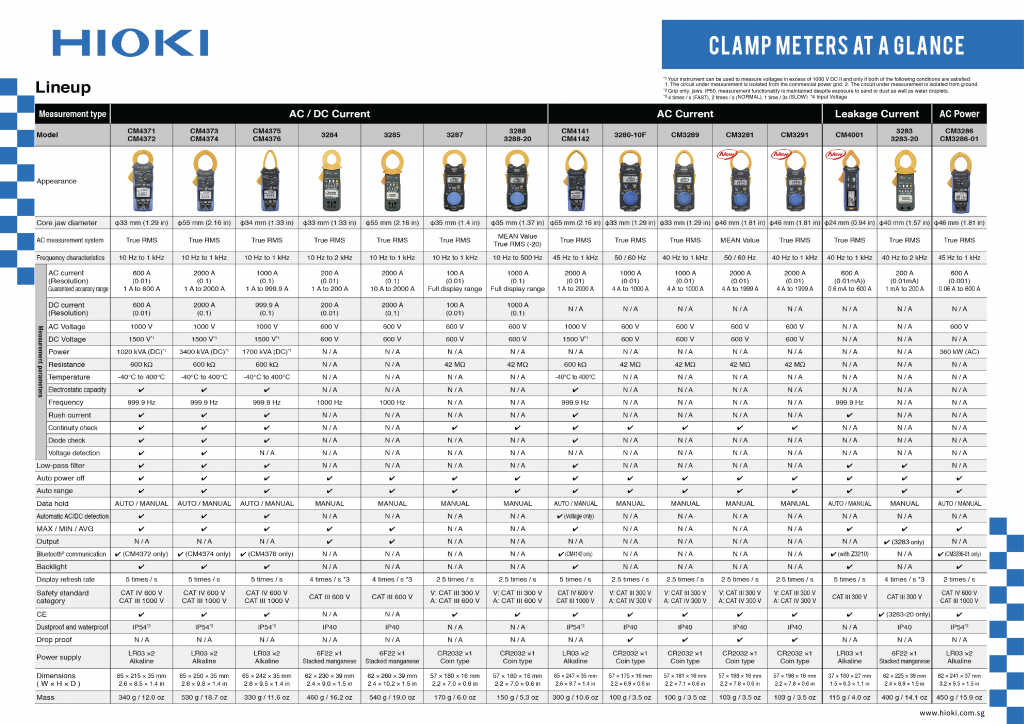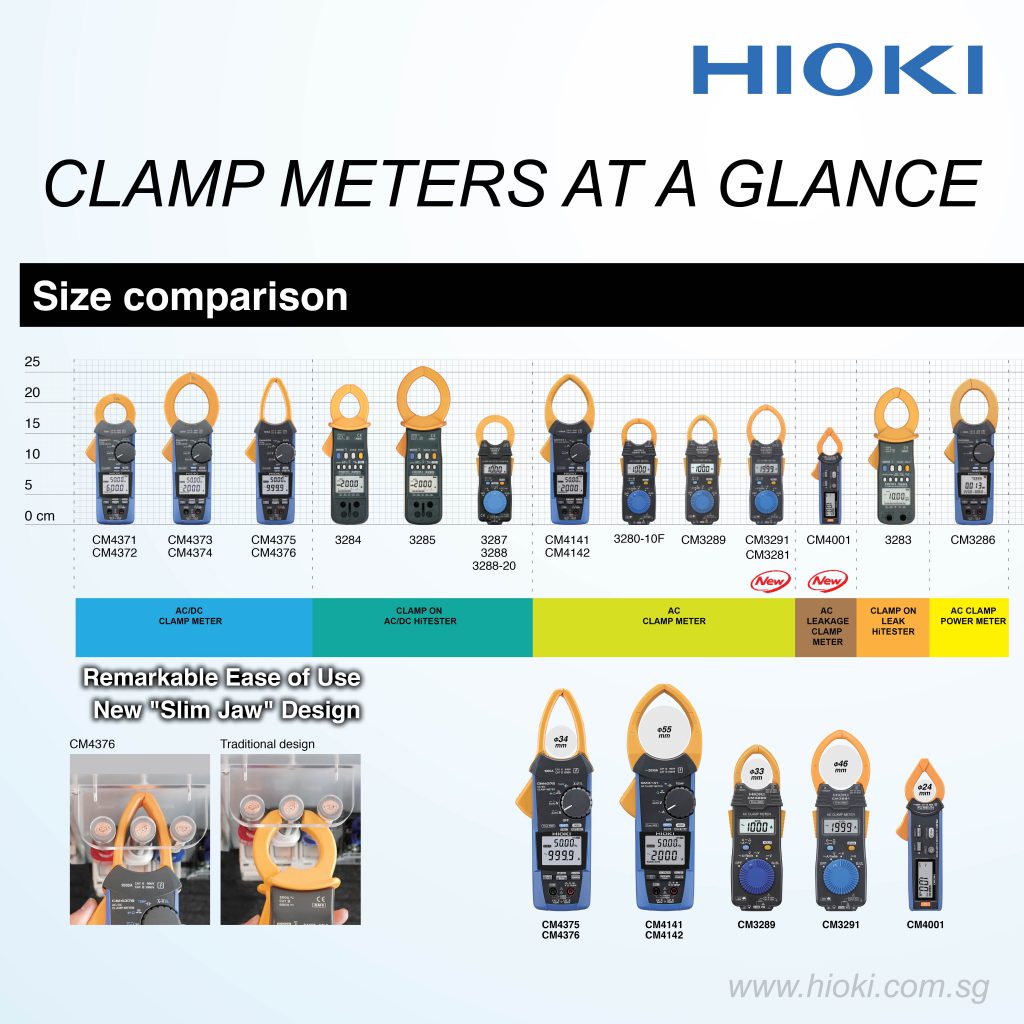Clamp Meters
AC/DC Clamp Meters
AC/DC CLAMP METER CM4375• Easily get into tight spaces • 1000 A AC/DC range • V, A, Hz, Ω, and other extensive measurement parameters
|
|
AC/DC CLAMP METER CM4376• Easily get into tight spaces • 1000 A AC/DC range • V, A, Hz, Ω, and other extensive measurement parameters • Built-in Bluetooth (R) wireless technology
|
|
DISPLAY UNIT CM7291• Built in Bluetooth®wireless technology • Use with CT7000 series • DCA, ACA, (DC+AC)A, frequency • WAVE, RMS, PEAK, Hz output
|
|
AC/DC CLAMP METER CM4374• 600/2000 A range • V, A, Hz, Ω, and other extensive measurement parameters • Inrush current • Built-in Bluetooth® wireless technology
|
|
AC/DC CLAMP METER CM4372• 20/600 A range • V, A, Hz, Ω, and other extensive measurement parameters • Inrush current • Built-in Bluetooth® wireless technology
|
|
DISPLAY UNIT CM7290• Use with CT7000 series • DCA, ACA, (DC+AC)A, frequency • WAVE, RMS, PEAK, Hz output
|
|
AC/DC CLAMP METER CM4371• 20/600 A range • V,A,Hz,Ω or other, extensive measurable parameters • Inrush current
|
|
AC/DC CLAMP METER CM4373• 600/2000 A range • V,A,Hz,Ω or other, extensive measurable parameters • Inrush current
|
|
WIRELESS CLAMP LOGGER LR8513• For AC/DC current recording • Fastest 0.5 sec interval • Wireless data download to a tablet or computer
|
|
CLAMP ON AC/DC HiTESTER 3287• For AC/DC measurement • True RMS • 10/ 100 A range • Light weight 170 g, 16 mm thin body • DMM function
|
|
CLAMP ON AC/DC HiTESTER 3288• For AC/DC measurement • True RMS (3288-20) • Average rectified (3288) • 100/ 1000 A range • Light weight 150 g, 16 mm thin body • DMM function
|
|
CLAMP ON AC/DC HiTESTER 3284• For AC/DC measurement • True RMS • 20/ 200 A range • DC/ AC/ AC+DC mode • Peak value at inrush current
|
|
CLAMP ON AC/DC HiTESTER 3285• For AC/DC measurement • True RMS • 200/ 2000 A range • DC/ AC/ AC+DC mode • Peak value at inrush current
|
AC Clamp Meters
|
|
|
|
|
|
AC CLAMP METER CM4141Uniquely designed sensor easily gets into narrow gaps Rugged build, tough against harsh environments • Easily get into tight spaces • 60 to 2000 A AC range • V, A, Hz, Ω, and other extensive measurement parameters
|
|
AC CLAMP METER CM4142Uniquely designed sensor easily gets into narrow gaps • Easily get into tight spaces • 60 to 2000 A AC range • V, A, Hz, Ω, and other extensive measurement parameters • Built-in Bluetooth (R) wireless technology
|
|
AC CLAMP METER CM3289• Get into even more confined spaces • 42 to 1000 A AC range • DMM function
|
|
AC CLAMP METER 3280-10F• 42 to 1000 A AC range • Weighing only 100g with thin 16 mm body • DMM function
|
|
CLAMP LOGGER LR5051• 2ch • AC current recording • 1 sec logging interval
|
AC Current Measurement Options
CLAMP ON ADAPTER 9290-10• Primary 1000A, secondary 100A (1/10 ratio) output • Superior phase angle characteristics for power
|
Leakage Current Clamp Meters
|
|
|
WIRELESS CLAMP LOGGER LR8513• For AC/DC current recording • Fastest 0.5 sec interval • Wireless data download to a tablet or computer
|
|
CLAMP ON EARTH TESTER FT6380• Earth resistance measurements for multi-grounded systems • Leak to load current • True RMS
|
|
CLAMP ON EARTH TESTER FT6381• Earth resistance measurements for multi-grounded systems • Leak to load current • True RMS • Automatic measurement report function with Android™ connectivity (FT6381 only)
|
|
CLAMP LOGGER LR5051• 2ch • AC current recording • 1 sec logging interval
|
|
CLAMP ON LEAK HiTESTER 3293-50• True RMS • 30 mA leak current range with 10 µA resolution • 1000 A max. load current
|
|
CLAMP ON LEAK HiTESTER 3283• True RMS • AC leak current and load current testing • 10 mA leak current range with 10 µA resolution • Load current up to 200 A
|
Clamp Power Meters
AC CLAMP POWER METER CM3286• Easy AC power checker • Single-phase, 3-phase (balanced condition/without distortion) • Phase angle, power factor
|
Connecting instruments in the field with IT
GENNECT CROSS SF4071, SF4072• Streamline tasks that require repeated measurement and recording of values • Available for Android and iOS
|
AC CLAMP METER CM4141• Easily get into tight spaces • 60 to 2000 A AC range • V, A, Hz, Ω, and other extensive measurement parameters
|
|
AC CLAMP METER CM4142• Easily get into tight spaces • 60 to 2000 A AC range • V, A, Hz, Ω, and other extensive measurement parameters • Built-in Bluetooth (R) wireless technology
|
|
AC CLAMP METER CM3289• Get into even more confined spaces • 42 to 1000 A AC range • DMM function
|
|
AC CLAMP METER 3280-10F• 42 to 1000 A AC range • Weighing only 100g with thin 16 mm body • DMM function
|
|
CLAMP LOGGER LR5051• 2ch • AC current recording • 1 sec logging interval
|
AC Current Measurement Options
CLAMP ON ADAPTER 9290-10• Primary 1000A, secondary 100A (1/10 ratio) output • Superior phase angle characteristics for power
|
Clamp Meters for Leakage Current Test
WIRELESS CLAMP LOGGER LR8513• For AC/DC current recording • Fastest 0.5 sec interval • Wireless data download to a tablet or computer
|
|
CLAMP ON EARTH TESTER FT6380• Earth resistance measurements for multi-grounded systems • Leak to load current • True RMS
|
|
CLAMP ON EARTH TESTER FT6381• Earth resistance measurements for multi-grounded systems • Leak to load current • True RMS • Automatic measurement report function with Android™ connectivity (FT6381 only)
|
|
CLAMP LOGGER LR5051• 2ch • AC current recording • 1 sec logging interval
|
|
CLAMP ON LEAK HiTESTER 3293-50• True RMS • 30 mA leak current range with 10 µA resolution • 1000 A max. load current
|
|
CLAMP ON LEAK HiTESTER 3283• True RMS • AC leak current and load current testing • 10 mA leak current range with 10 µA resolution • Load current up to 200 A
|
Clamp Power Meters
AC CLAMP POWER METER CM3286• Easy AC power checker • Single-phase, 3-phase (balanced condition/without distortion) • Phase angle, power factor
|
Connecting instruments in the field with IT
GENNECT CROSS SF4071, SF4072• Streamline tasks that require repeated measurement and recording of values • Available for Android and iOS
|
01. How to use clamp meters
-
How to use load current clamp meters
-
When measuring load current in a 1-phase 2-wire circuit as shown in the figure, the clamp meter should be applied around one (not both) of the wires.
Because the current flowing to and from the load in the two wires forms a pair of magnetic fields that are opposite one another, the two magnetic fields cancel each other out, causing the clamp meter to indicate a current value of zero if two wires are measured at the same time.
When measuring a 3-phase circuit, it is necessary to measure the current value in each of the R, S, and T wires by applying the clamp meter to each in turn.
-
How to use leakage current clamp meters
-
When measuring leakage current in a 1-phase/2-wire circuit as shown in the figure, the clamp meter should be applied around both wires.
Because the current flowing to and from the load in the two wires forms a pair of magnetic fields that are opposite one another, there will be a difference in the two fields if there is any leakage current. The measured current value when the clamp meter is applied around both wires at the same time is the leakage current.
When measuring a 3-phase circuit, the clamp meter should be applied around the R, S, and T wires (all three wires) at once. Leakage current can also be measured by applying the clamp meter around a grounding wire.
02. Clamp meter functions and how to use them
-
Current measurement
-
• Set the rotary switch as shown in “1”.
• Enable zero-adjustment as shown in “2”.
• Apply the clamp meter around the wire as shown in “3”.
• Determine the function as appropriate from auto, AC current, DC current, AC+DC current, or frequency as shown in “4”.*This example uses the Clamp Meter CM4370 series.
-
HOLD function
-
MANUAL HOLD:
• The measured value on the display can be held by pressing the HOLD key.AUTO HOLD:
• Press and hold the HOLD key for 1 sec. to enable the auto hold function.
• Once the measured value stabilizes, it will be automatically held as shown in the figure.
• The measured value will continue to be held once the clamp is removed from the wire.
• Once you apply the clamp meter around another wire and the measured value stabilizes, it will be automatically held again.
• This function is convenient when you need to make and record results for a series of measurements.*This example uses the Clamp Meter CM4370 series.
-
Filter function
-
• The filter can be applied based on a 100 Hz cutoff frequency.
• This function is convenient when you wish to measure the current value near the power supply frequency without being affected by noise or other interference.*This example uses the Clamp Meter CM4370 series.
-
MAX/MIN/AVG/PEAK
-
• The MAX/MIN/AVG function records the maximum, minimum, and average values for the measured value (RMS) interval being displayed.
• The peak max and peak min functions display the maximum and minimum values of current waveform peaks after 10 kHz sampling.*This example uses the Clamp Meter CM4370 series.
-
DC current and DC voltage PEAK measurement
-
• Apply the clamp around the wire coming from the vehicle battery’s positive terminal as shown in “1” in the figure and set the rotary switch as shown in the figure.
• Operate the control key as shown in “2” in the figure.
• Start the vehicle’s engine.
• By performing the steps shown in “4” in the figure, you can read the maximum and minimum values for the instantaneous DC current when the engine is started as well as the DC voltage maximum and minimum values.*This example uses the Clamp Meter CM4370 series.
-
Inrush current measurement (INRUSH)
-
• Disconnect the power supply of the motor or other load.
• Determine the appropriate position for the rotary switch as shown in “2” in the figure.
• Perform zero-adjustment as shown in “3” in the figure.
• Apply the clamp around one of the load circuit’s wires as shown in “4” in the figure.
• Enable the INRUSH function as shown in “5” in the figure.
• Start the motor or other load.
• As shown in “7” in the figure, you can read the peak (maximum peak value) and RMS value for the interval during which the inrush current (starting current) occurs.*This example uses the Clamp Meter CM4370 series.
-
Other measurement functions: Voltage measurement
-
• Connect the measurement leads to the clamp meter.
• Set the rotary switch to voltage measurement as shown in “1” in the figure.
• Place the measurement leads in contact with the point you wish to measure as shown in “2” in the figure.
• Select the desired function (auto, AC voltage, DC voltage, AC+DC voltage, or frequency) as shown in “3” in the figure.*This example uses the Clamp Meter CM4370 series.
-
Other measurement functions: Continuity check, Resistance, Diode
-
• Set the rotary switch to the position shown in the figure.
• Using the SHIFT key, you can check continuity or perform resistance or diode measurement.*This example uses the Clamp Meter CM4370 series.
-
Other measurement functions: Capacitance, Temperature
-
• After setting the rotary switch to TEMP, you can use the SHIFT key to perform capacitance or temperature measurement.
*This example uses the Clamp Meter CM4370 series.
-
Other measurement functions: Electric charge detection, Simultaneous display of DC current and voltage, DC power
-
After determining the rotary switch position as shown in the figure, you can use the SHIFT key to detect a voltage, simultaneously display DC current and voltage, or measure the DC power being produced by a solar power system.
*This example uses the Clamp Meter CM4370 series.
03. Clamp meter measurement principles
-
Clamp meter measurement principles: CT method
-
Clamp meters measure current by using a sensor to detect the magnetic field produced by a flowing current and then converting the result to obtain the current. The measurement method and principle used by CT-type clamp meters are described below.
Design:
Coil wound around a magnetic corePrinciple:
In this application of the principle of a transformer, the primary side consists of one winding (the wire around which the clamp has been applied), and the second side consists of N windings (the wire wound around the magnetic core). This arrangement is used to measure current. Due to the principle that is applied, caution is necessary if a current flows to the primary side while the secondary side is in the open state as a high voltage may occur at the open terminal due to the tendency of a current to develop on the secondary side of the device under such conditions.Advantages:
Linearity and broad measurement rangeDisadvantages:
Inability to detect DC currents -
Clamp meter measurement principles: Hall element method
-
Clamp meters measure current by using a sensor to detect the magnetic field produced by a flowing current and then converting the result to obtain the current. The measurement principle used in the Hall element method is described below.
Design:
Hall element embedded in a magnetic corePrinciple:
The magnetic field produced by the wire around which the clamp has been applied is converted to a voltage by the Hall element, and the voltage is converted to a current.Advantages:
Ability to measure both DC currents and AC currentsDisadvantages:
Significant impact of sensor enclosure, magnetic circuit, and magnetic core design on instrument performance -
Clamp meter measurement principles: Rogowski method
-
Clamp meters measure current by using a sensor to detect the magnetic field produced by a flowing current and then converting the result to obtain the current. The measurement principle used in Rogowski-type clamp meters is described below.
Design:
Rogowski coil wound around a coreless, nonmagnetic materialPrinciple:
Differentiated voltage waveforms are output at both ends of the coil depending on the current. The waveforms are integrated to calculate the current.Advantages:
Flexibility due to the absence of a core, broad frequency bandDisadvantages:
Limited to measurement of AC currents

